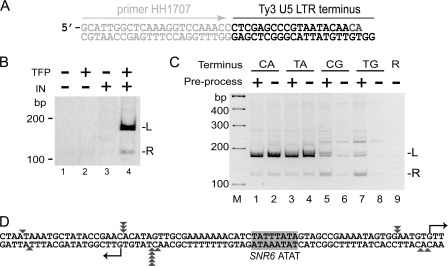FIGURE 2.
Recombinant Ty3 IN mediates targeted strand transfer with duplex oligonucleotide substrates. A, duplex oligonucleotide substrate. The duplex oligonucleotide substrate for strand transfer: left end (light gray): 23 bp sequence complementary to PCR primer HH1707; right end (black): 20/22 nt sequence of Ty3 LTR U5 terminus lacking the two 3′-nt removed by processing (preprocessed). B, recombinant IN mediates strand transfer of duplex Ty3 LTR U5 substrate. Duplex preprocessed oligonucleotide substrate (A) was incubated in the absence and presence of TFP and recombinant IN as described under “Experimental Procedures.” PCR was performed on the products using primers HH1707 and 242 and products were fractionated as described in the Fig. 1 legend. C, recombinant IN mediates strand transfer of unprocessed and preprocessed substrates and is sensitive to substrate sequence. Strand-transfer assays were as in B except that substrates were either preprocessed (+) or blunt-end (−) and the terminal 2 nt of the Ty3 IR (5′-CA-3′) were varied as shown. R, DNA substrate in which random 22 nt replaced Ty3 U5 sequence (oligonucleotides HH1798 and HH1799). D, target sites of strand transfer. Products of four strand-transfer reactions (B, lane 4) were cloned and sequenced. Strand-transfer joints between Ty3 U5 and target sequence are shown (triangles). Multiple triangles at the identical site in all three cases represent two independent reactions. Eleven independent sites were identified.

